You are here
Home 🌿 Medical Cannabis News 🌿 Could Thailand, Which Gave World the Bong, Legalise Cannabis for Medicinal Use? After Failed War on Drugs, Attitudes Have Softened 🌿Could Thailand, Which Gave World the Bong, Legalise Cannabis for Medicinal Use? After Failed War on Drugs, Attitudes Have Softened
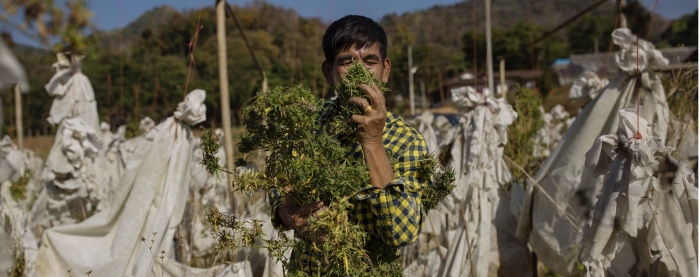
Thaksin Shinawatra considered legalising marijuana, and recently a justice minister aired same idea, amid mounting evidence of its medicinal benefits. If it happened, it could be a game changer for drug policy in Southeast Asia.
It’s early spring, and the splendour peach and guava blossoms bestow on the plantations and orchards in this part of northern Thailand is still a few weeks away. But some would see beauty already, in a huddle of chest-high plants draped with thin, white garden cloth for protection.
For here – in the middle of a field in a valley outside the city of Chiang Mai – grow the first cannabis plants cultivated openly in the country for many years.
In the 1980s, Thailand was a leading exporter of the plant and its narcotic bounty. With American encouragement, the trade was extinguished, but lately attitudes have been changing in both countries. The specimens at the Royal Agricultural Station Pang Da and in surrounding commercial plantations are hemp and low on the psychoactive constituent tetrahydrocannabinol (THC). They will be used mainly for their fibre and nutritional oils.
However, more potent variants, grown for recreational as well as medicinal purposes, could be introduced if plans to fully legalise the plant are realised, perhaps marking a turning point for Southeast Asia, where drug policies rank among the harshest in the world, and indeed for the whole of Asia.
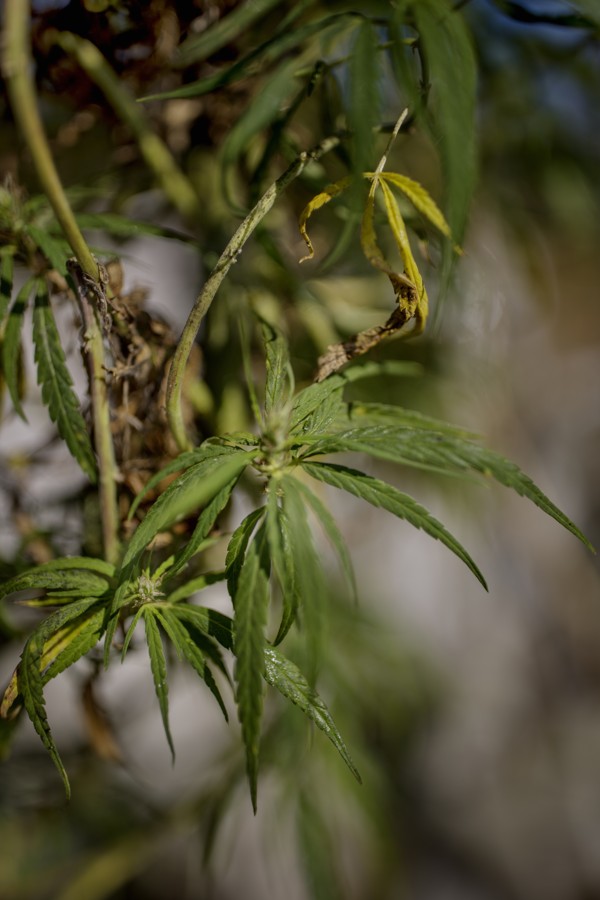
Over the past four decades, the global approach towards narcotics has been primarily punitive. Zero tolerance, compulsory minimum sentences and expanded authority for law enforcement have been the norm.
However, an increasing number of countries are reconsidering this approach. To lock up drug offenders has proven both costly and ineffective. Instead, the trend is towards health care and harm reduction.
Southeast Asia remains an exception, however. In Singapore, cannabis users risk up to 10 years in prison. Smugglers in Indonesia are executed, no matter where they are from or how hard their governments fight for their reprieve. And between June last year and February, an estimated 7,000 people were killed in the Philippines for alleged involvement in the illegal drug trade. Most were shot in the street, with the government’s blessing.
Last week, it was reported that the Malaysian Maritime Enforcement Agency had fished out US$422,000 worth of cannabis dumped at sea by the crew of a fishing boat, the smugglers having been panicked by an approaching speedboat.
In Hong Kong, “any person who cultivates any plant of the genus cannabis [...] shall be liable upon conviction to a fine of HK$100,000 and imprisonment for 15 years”, according to the Police website.
Thailand set the scene for the region’s war on drugs in 2003. In the three months following the enactment of “extreme measures” by prime minister Thaksin Shinawatra to stamp out the selling of methamphetamines, more than 2,000 people were killed, sentences were lengthened and prisons overflowed. Today, the country is home to 10 per cent of Southeast Asia’s inhabitants and 40 per cent of its prisoners. Drug use, meanwhile, is on the rise.
Its failure is so obvious that, in 2016, Thailand’s then justice minister, Paiboon Koomchaya, declared the war on drugs lost. Legalising cannabis was one of his proposed solutions. The idea was that legal mild highs would dissuade users from experimenting with harder drugs.
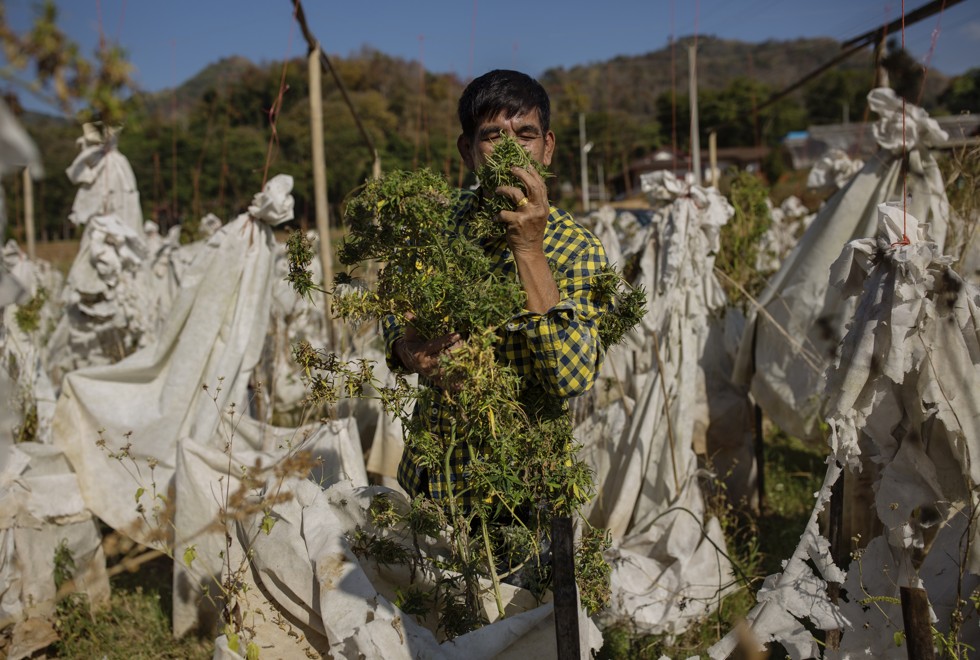 Buntoon at the Royal Agricultural Station Pang Da.
Buntoon at the Royal Agricultural Station Pang Da.
Some hope such an approach will also make the country healthier and attract more medical tourism.
Buntoon Niyamapha’s home in the capital, Bangkok, is a drug laboratory adorned with Disney posters: Beauty and the Beast and The Fox and the Hound look over a table covered with small medicine bottles as Buntoon’s sister and wife fill the glass containers with liquid from pipettes.
In an inner room, Post Magazine is shown dark paste drying in a pan next to a fan, surrounded by laboratory equipment.
“Pure THC,” Buntoon says, proudly. He has honed his extraction process since 2012, when his sister, Kamootpon, was diagnosed with uterine wall cancer. First, he convinced her to drink hot water mixed with the narcotic buds of the marijuana plant. (The terms cannabis and marijuana can be used interchangeably).
“I was scared stiff until my brother showed me studies online,” she says. The cancer has gone, but Kamootpon continues to apply a drop of oil under her tongue each night. “I feel healthy and sleep much better,” she adds.
For Buntoon, who enjoys smoking the drug, cannabis is no longer merely recreational – it has become a calling. He cooks two to three kilos of plants every day, and donates the resulting oil to “at least 200 people” in need.
“This is charity, not a business,” he emphasises. “I’m the Robin Hood of cannabis.”
His merry band are medical marijuana enthusiasts with growing influence. In a few years, they have gone from being on the fringe of society to arranging seminars with government representatives. Among the participants at these gatherings are always a group of converts who testify to the positive effects the plant has had on them.
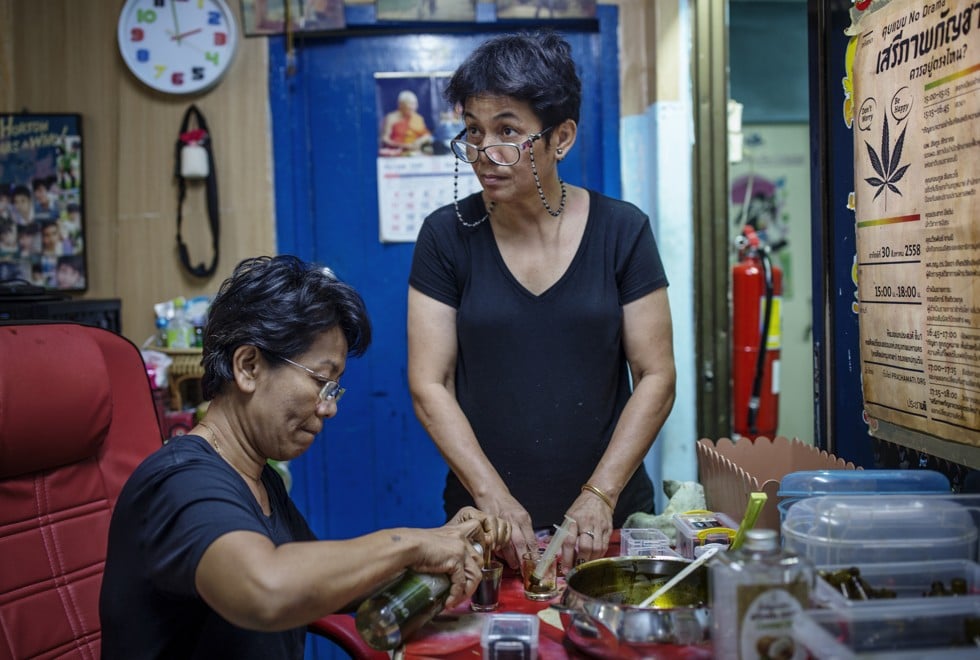 Buntoon’s sister, Kamootpon (left), and his wife fill bottles with cannabis oil in their Bangkok home.
Buntoon’s sister, Kamootpon (left), and his wife fill bottles with cannabis oil in their Bangkok home.
Nivate Pipatanatiganant was diagnosed with cancer of the small intestine in 2002. When he was told he had just two months to live, he stopped his chemotherapy and started experimenting. He became a monk, radically changed his diet and started taking cannabis.
“The only thing I knew about cannabis was that it was an illegal drug that you could become addicted to,” he says. “But when you’re drowning, you don’t care; then you try anything.”
Nivate was inspired by a course in traditional Thai medicine. Cannabis has been used in the country for about 2,000 years, for recreation, nutrition and as an analgesic and sedative in massage oils. However, because of prohibition, Nivate had to turn to the black market, and improvise. Since he didn’t smoke, he mixed his marijuana in a bottle of vodka, and drank a small shot every morning and night.
“I didn’t dare tell my doctor I’d taken cannabis. He still thinks it’s a miracle,” he says. “I believe God gave me cancer to spread the knowledge to other patients.”
Anecdotal evidence of the healing powers of cannabis has been offered for millennia. According to Shennong’s pharmacopoeia, a Chinese collection of medical prescriptions said to be 4,700 years old, cannabis alleviates malaria, rheumatism and, of all things, absent-mindedness. Physicians in the West were using the plant right up until it was prohibited, in the late 1930s.
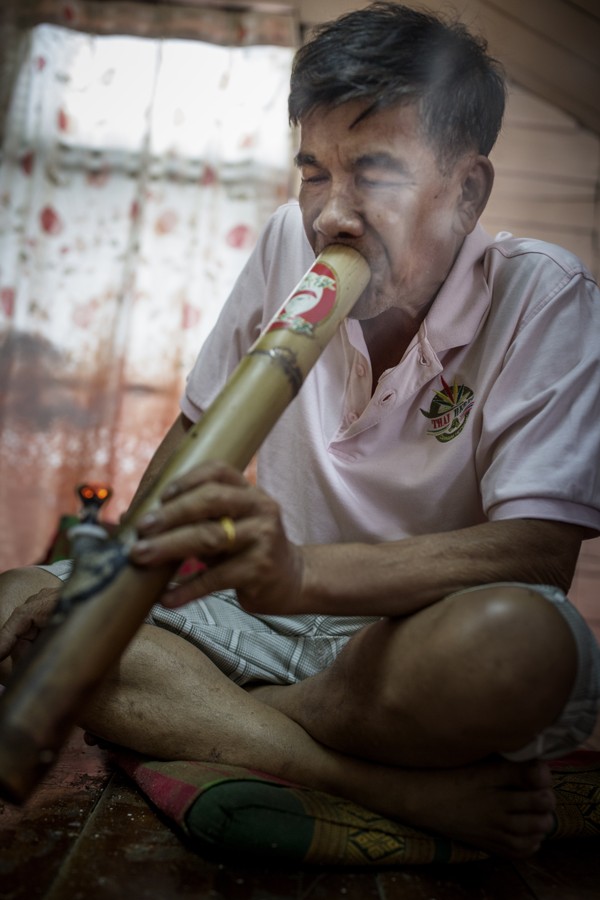
Google “marijuana” and the name of almost any disease, and you will find a plethora of fantastic testimonials, as well as stories of how the “establishment” has conspired to keep the plant out of the hands of the public.
Cannabis has played an important role in shaman rituals since the Stone Age, and the leaf of the plant has become a symbol of the modern counterculture, which has not helped its credibility.
Thailand played a major role in that development. In the 1960s, United States servicemen fighting communist forces in neighbouring Vietnam and Laos were either based in the country or visited for rest and recuperation. Many started smoking cannabis through bamboo pipes – “baungs”, or, as the Americans called them, “bongs” – and later took the habit home with them, along with, through intricate smuggling networks, the produce.
Soon cannabis came to play a central role in the anti-war movement. As that war was lost, the US government launched another, against drugs, the new “public enemy No 1”. Cannabis was categorised as being among the most harmful illegal substances, worse even than amphetamines and cocaine. In Thailand, the US helped officials eradicate plantations, effectively pushing them over the border into Laos, and burn bongs.
The recent change in attitudes has been sweeping. Twenty-five of 50 American states have legalised marijuana for medical use, and eight, from Alaska in the west to Maine in the east, allow it for recreational purposes, too. Cannabis has become the country’s fastest growing industry and, according to the analyst firm New Frontier Data, will create more US jobs than manufacturing by 2020.
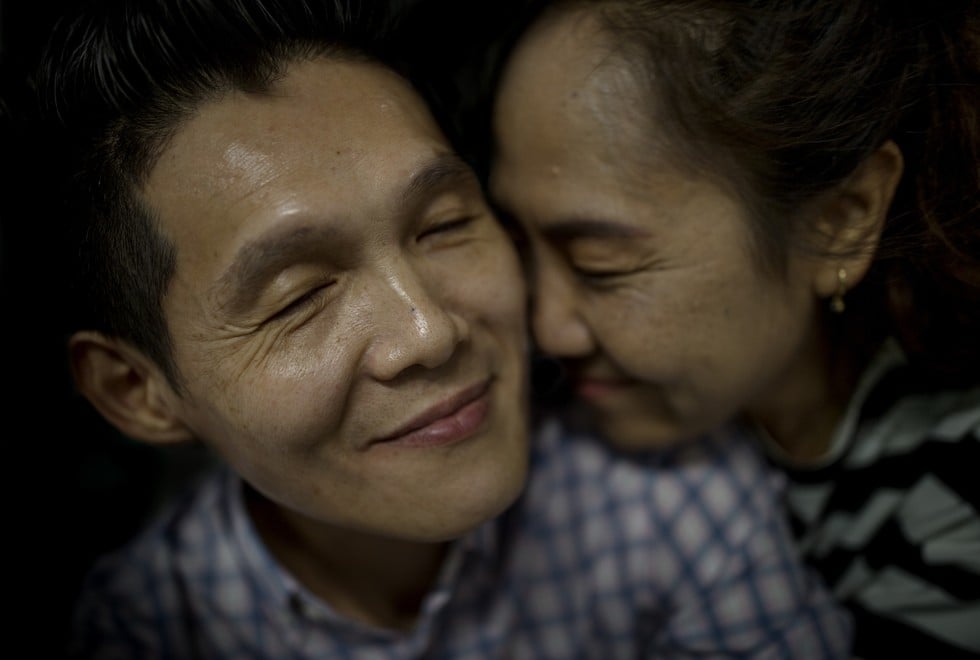 Nivate Pipatanatiganant with his wife.
Nivate Pipatanatiganant with his wife.
More than 30 other countries have moved in the same direction. And they are being led by statistics and science, which has shown that harsh sentencing laws do not lessen drug abuse and that cannabis is not chemically addictive and it is not possible to overdose on the drug.
Furthermore, it has been proved that the substance can help alleviate symptoms in a range of conditions, from Crohn’s disease and Tourette’s syndrome to multiple sclerosis and asthma. Acknowledging this in 2015, then US surgeon general Vivek Murthy urged political action and further research, “to see what the science tells us about the efficacy of marijuana”.
In the meantime, Southeast Asia remains caught between extremes. Personally, many Asians are tolerant of drug use so long as it doesn’t adversely affect them. For instance, Philippine President Rodrigo Duterte has admitted to adjusting his dosage of the highly potent and potentially addictive painkiller fentanyl for pleasure, but that has not visibly eroded support for his war on drugs.
And when it comes to cannabis, Thailand is far from the only country in the region that has a long history with the plant. On the other hand, many Southeast Asians are upset about the degeneration that can be a consequence of narcotic use. The media sells images of violence, crime and corruption, and cannabis is portrayed as a “gateway drug” leading to use of more insidious substances. Tough words win elections and punishing users and dealers in poor areas is often both cheap and popular.
In Thailand, cannabis is categorised as being among the least harmful illegal drugs. Even at the onset of the country’s war on drugs, Thaksin considered legalising it. The time was not right, he concluded. But it may now be, in light of the West’s reappraisal of the plant.
For the past few years, a group of former US residents now returned to their homeland have been publishing the marijuana magazine Highland; musicians are performing songs about the plant; and, once again, bongs are being sold openly in Thailand.
 Bangkok resident Sasinan Sithong administers cannabis oil to her six-year-old daughter, Navaphorn, who suffers from cerebral palsy.
Bangkok resident Sasinan Sithong administers cannabis oil to her six-year-old daughter, Navaphorn, who suffers from cerebral palsy.
Last year, the debate intensified when a book titled Marijuana is a Medicine That Cures Cancer began to garner media attention. Its author, Dr Somyot Kittimunkong, spent time with Thai cancer patients who self-medicated with cannabis and wrote about their often remarkable results.
It is no academic paper, and Somyot is a dermatologist, but the book aroused the interest of a public open to alternative medical treatments. And recent research has shown that his claims – and those of his subjects – may not be outlandish.
For years, cannabinoids, the primary psychoactive compound in cannabis, have proved effective against cancer in mice. In February, British company GW Pharmaceuticals presented the results of a study carried out on humans. It compared two groups of people with aggressive brain tumours. Those treated with a drug combining cannabidiol and THC, the “high” producing element of cannabis, had a median survival rate of about six months longer than those who took a placebo.
Swayed by the mounting evidence, in January, Thailand approved a proposal to allow hemp, which produces the non-intoxicating cannabidiol, to be grown in 15 districts.
 Sasinan shares her experience of administering cannabis oil to treat her daughter’s cerebral palsy at a conference on legalising marijuana, in Bangkok, in March. Next to them sits a man with Parkinson’s disease who uses medicinal marijuana.
Sasinan shares her experience of administering cannabis oil to treat her daughter’s cerebral palsy at a conference on legalising marijuana, in Bangkok, in March. Next to them sits a man with Parkinson’s disease who uses medicinal marijuana.
“The problem in Thailand is that people [have been turning] to cannabis only as a last resort,” Somyot says. “That leaves scant time for the drug to take effect.”
Some physicians go so far as to assist in the treatment. Somnuk Siripanthong, at Bangkok holistic health centre Panacée, arranges open meetings in the church he attends. There, he informs people about the healing powers of cannabis and administers Buntoon’s oil. The gatherings attract people with all kinds of sicknesses, but cancer is the one that most interests Somnuk.
“Radiation and chemotherapy work on some patients,” he says. “Others deteriorate quickly.” He holds an imaginary pistol against his head and pulls the trigger. “Click, you’re OK, bang, you’re dead. For a long time, we didn’t know why. Now, we’ve found that some people have a genetic mutation that leads to a very weak immune system. Cannabinoids have shown very good results in amending that, and helping the body kill the cancer.”
Perhaps because Somnuk is connected with the government and Buntoon is an ex-officer, the police have ignored their advocacy of cannabis. The pair would rather have the law on their side, though, to be able to properly test their product and adjust doses.
Also, they see economic potential in legalisation; cannabis could be yet another draw to what is already one of the world’s top five health tourism destinations, attracting almost three million people each year – a significant number of them from Hong Kong.
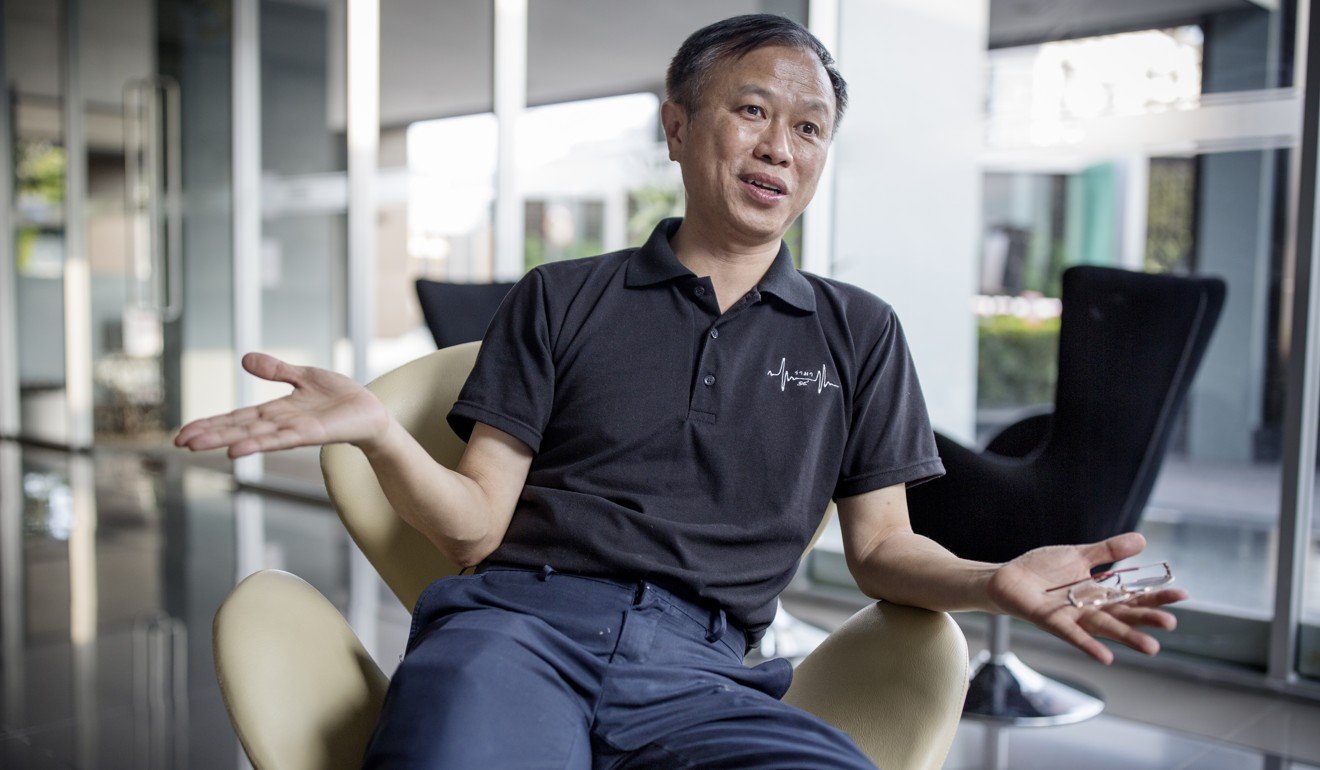 Somnuk Siripanthong
Somnuk Siripanthong
“Health centres with cannabis for foreigners could pay for free treatments for Thais,” says Somnuk, who believes Thailand could once again become respected for its weed. “In Canada they build greenhouses, but here you only need to throw the seeds on the ground for them to grow.”
The road to full legalisation may still be a long one. The man who pushed for it, former justice minister Paiboon, has been promoted to the king’s Privy Council and the torch is yet to be picked up by another government representative.
And there are those who still have an interest in stomping out the flame; the full legalisation of cannabis could mean diminished latitude for the police, some of whom make considerable sums of money from bribes and drug seizures.
“Reforming drug policy means involving the police as an essential and fundamental pillar,” says Olivier Lermet, regional adviser at the United Nations Office on Drugs and Crime (UNODC). “They must understand the goal and their role in it.”
Thai authorities have long been involved in the drug trade. The government managed an opium monopoly well into the 1950s, the military then established links to the opium-growing Shan state, in Myanmar, and the police secured the export routes for the produce, according to the book The Politics of Heroin (1972).
Helped by the economic and military support the US provided to anti-communist forces, these developments gave birth to the Golden Triangle, the hills spanning Thailand, Myanmar and Laos that met much of the world’s opium demand into the 1990s.
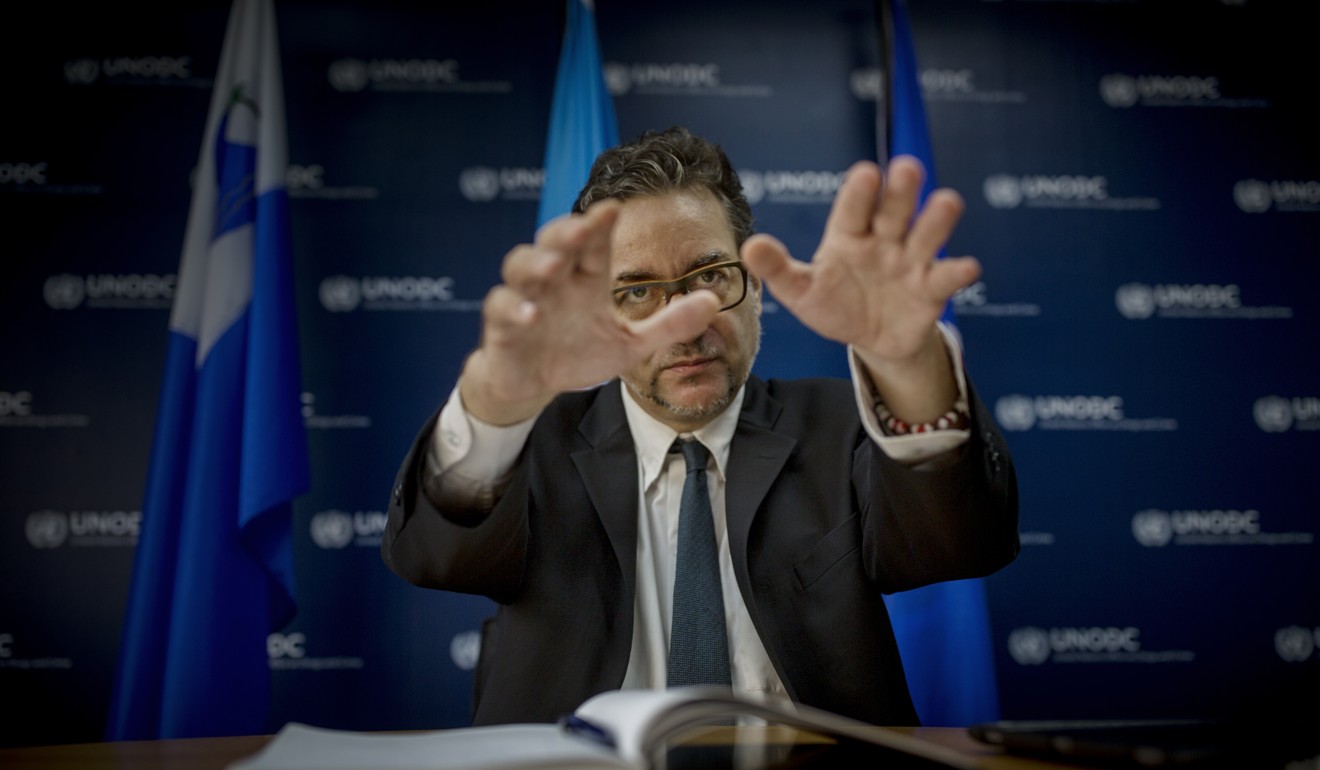 Olivier Lermet
Olivier Lermet
Although today the Thai authorities are officially trying to stamp out the drug trade, it still generates an estimated US$30 billion annually, according to the UNODC, and is linked to the similarly lucrative trafficking of wildlife and people.
Riches such as these naturally attract corruption. The meagre pay of police officers exacerbates the problem, as does the shaky state of the country’s democracy.
Yet there is a history of successful drug prevention in Thailand. Between 1965 and 2003, the country cut the acreage used for opium cultivation a hundredfold. The core driver was economic development; farmers in the northern hills were introduced to alternative cash crops.
That project has been praised as one of the most successful of its kind, and many of the model plantations that were set up in the process – such as the strawberry and tea plantations at the Khun Wang Royal Project Development Centre, near Chiang Mai – are today marketed as tourist destinations.
Visitors to Pang Da are greeted by a neatly cultivated valley. Beans, bitter gourd and Chinese cabbage chequer the field between sloping groves. And among them, since the beginning of the year, has been a patch of veiled plants, rising from the ground like a bridal train – the first new shoots, perhaps, of a valuable, healthy agricultural product.
420 Intel is Your Source for Marijuana News
420 Intel Canada is your leading news source for the Canadian cannabis industry. Get the latest updates on Canadian cannabis stocks and developments on how Canada continues to be a major player in the worldwide recreational and medical cannabis industry.
420 Intel Canada is the Canadian Industry news outlet that will keep you updated on how these Canadian developments in recreational and medical marijuana will impact the country and the world. Our commitment is to bring you the most important cannabis news stories from across Canada every day of the week.
Marijuana industry news is a constant endeavor with new developments each day. For marijuana news across the True North, 420 Intel Canada promises to bring you quality, Canadian, cannabis industry news.
You can get 420 Intel news delivered directly to your inbox by signing up for our daily marijuana news, ensuring you’re always kept up to date on the ever-changing cannabis industry. To stay even better informed about marijuana legalization news follow us on Twitter, Facebook and LinkedIn.





